Before interstate highways completely transformed American travel, family road trips meant meandering down two-lane highways where the journey was as important as the destination. The 1970s represented the golden twilight of roadside Americana – a time when bizarre attractions competed fiercely for tourist dollars with increasingly outlandish gimmicks. These quirky landmarks, often family-owned and operated, combined folksy charm with an undeniable touch of the uncanny. Let’s take a nostalgic (and slightly unnerving) journey back to the roadside attractions that made kids scoot closer to their parents and made parents wonder if they should have just sprung for plane tickets instead.
1. The Cabazon Dinosaurs
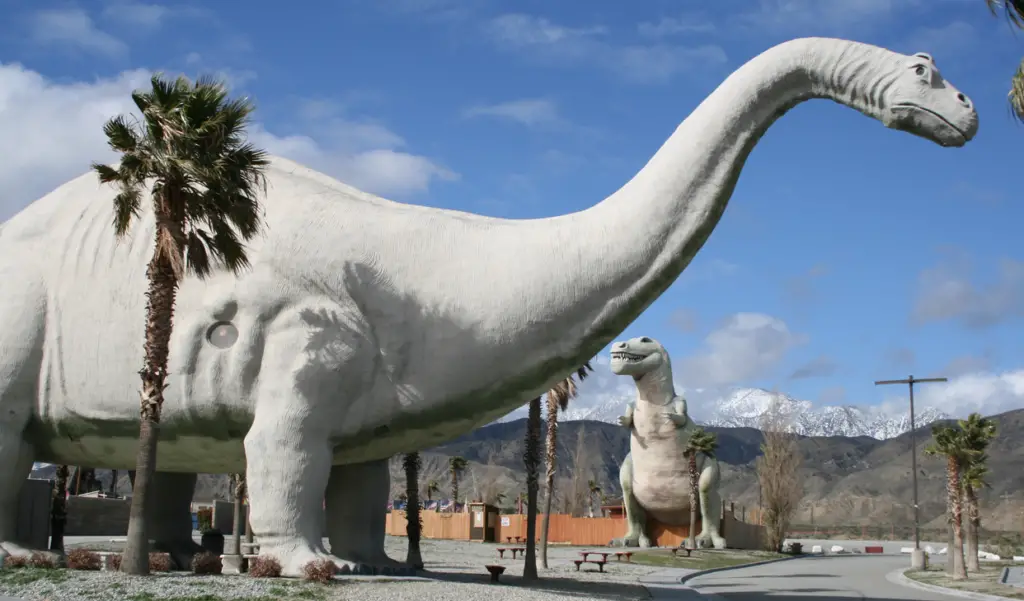
These massive concrete dinosaurs looming alongside Interstate 10 in California were both awe-inspiring and deeply unsettling, particularly at dusk when their silhouettes dominated the desert landscape. Built in the 1960s but reaching peak popularity in the ’70s, the 150-foot-long Brontosaurus (now known as Apatosaurus) and the 65-foot-tall Tyrannosaurus Rex created an otherworldly scene that felt like prehistoric monsters had somehow landed in the California desert. The hollow interior of the T-Rex, which housed a gift shop accessed by climbing stairs in its tail, featured small windows for eyes that glowed eerily at night, convincing many children that the beast might actually be alive. Atlas Obscura takes a walk down memory lane, of several millions of years, to explore the history behind this unique attraction.
Creator Claude Bell built these dinosaurs to attract customers to his nearby restaurant, clearly understanding that nothing says “stop for pancakes” like giant prehistoric predators. The dinosaurs later achieved cult status by appearing in the film “Pee-wee’s Big Adventure,” cementing their place in pop culture as landmarks that straddled the line between roadside kitsch and nightmare fuel. For ’70s kids pressed against station wagon windows as these behemoths appeared on the horizon, the dinosaurs represented both the thrilling and terrifying possibilities that might await at the next highway exit.
2. The Thing (Mystery of the Desert)
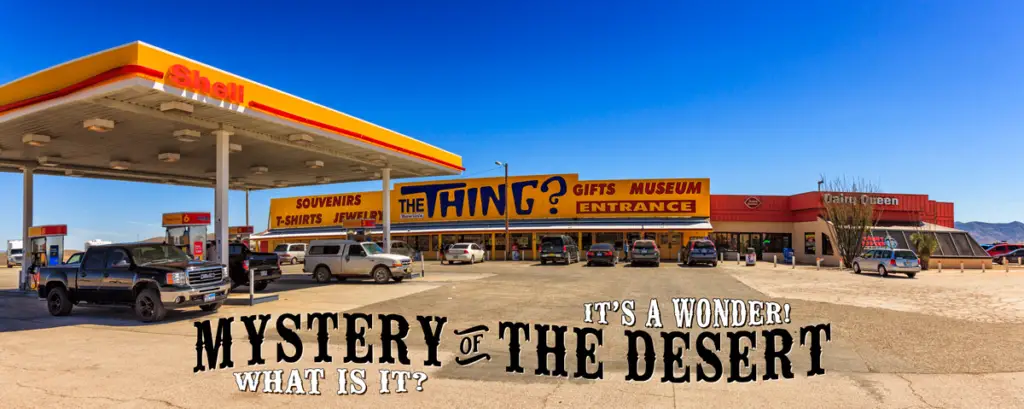
Perhaps the ultimate example of horror-tinged roadside marketing, “The Thing” in Arizona built anticipation through over 200 billboard advertisements spanning hundreds of miles, promising travelers they would soon encounter something inexplicable. Located between Benson and Willcox, Arizona, this attraction charged visitors a small fee to walk through a series of dimly lit sheds filled with dusty “oddities” before finally revealing its star attraction – a dubious mummified “mother and child” displayed in a concrete coffin. The questionable authenticity and poor lighting created an atmosphere that felt more like a low-budget haunted house than an educational exhibition. If you can believe it, according to The Arizona Republic, The Thing also got even stranger over the years compared to how it started.
The genius of “The Thing” was how it combined classic carnival barker techniques with the isolation of desert highways to create genuine suspense. Many families reported that the lengthy buildup far exceeded the payoff, but the mysterious billboards became such an iconic part of southwestern road trips that the actual exhibit almost didn’t matter. Kids who begged parents to stop after seeing dozens of teaser billboards often regretted their persistence when faced with the attraction’s unsettling collection of bizarre taxidermy, strange artwork, and that mummified “thing” which gave many youngsters nightmares for weeks afterward.
3. House on the Rock (Spring Green, Wisconsin)
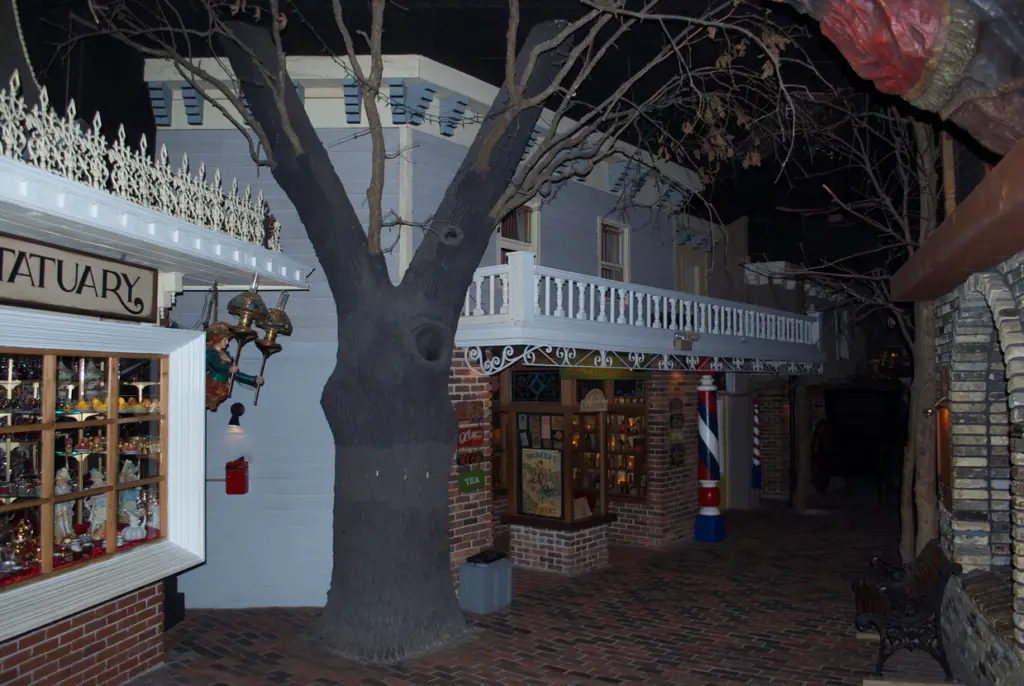
This sprawling, labyrinthine attraction began as an unusual house built by eccentric architect Alex Jordan Jr. atop a 60-foot chimney of rock, but expanded throughout the ’70s into a disorienting maze of collections that defied logic or curation. The darkened rooms housed everything from the world’s largest carousel (featuring not a single horse but instead 269 bizarre mythical creatures) to automated music machines that played ghostly tunes when visitors inserted tokens. With narrow walkways, strange lighting, and collections that included dolls, armor, model ships, and mechanical orchestras, the experience felt like wandering through the physical manifestation of a fever dream. According to Belt Magazine, this structure celebrated 60 years just a few years ago, a long stretch of time to successfully bewilder and intrigue travelers.
The “Infinity Room,” which extended 218 feet unsupported over the Wyoming Valley, gave visitors the unsettling sensation of floating above the landscape while surrounded by 3,264 windows. Perhaps most disturbing was the attraction’s seeming endlessness – just when visitors thought they had reached the exit, another room of oddities would appear, creating a disorienting experience that could last hours longer than expected. The House on the Rock perfected a particular brand of Midwestern weird that inspired author Neil Gaiman to feature it in his novel “American Gods,” acknowledging its power to unsettle even the most rational minds with its bizarre juxtapositions and lack of coherent narrative.
4. South of the Border (Dillon, South Carolina)
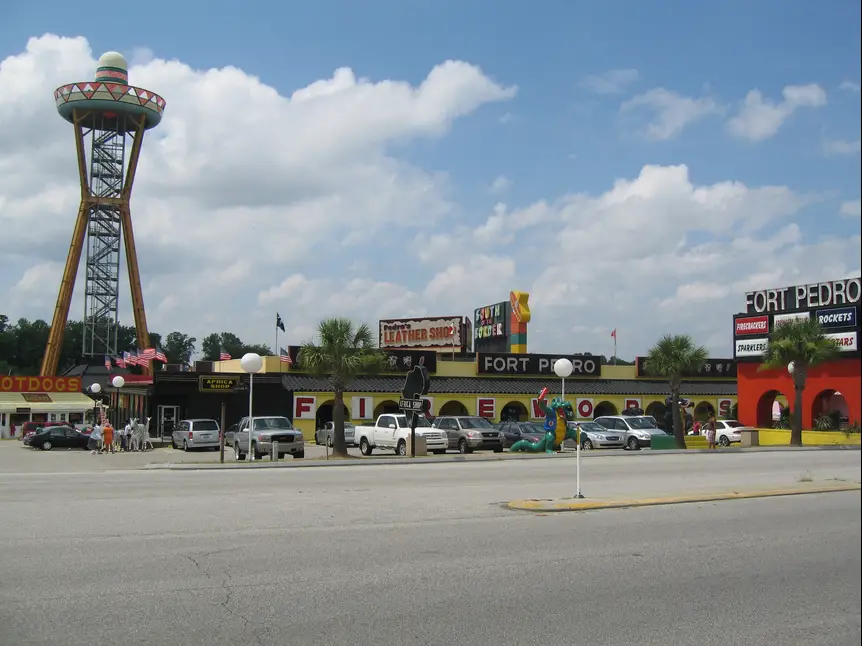
This Mexico-themed roadside stop just south of the North Carolina border bombarded travelers with hundreds of garish billboards featuring the mascot “Pedro,” whose stereotypical appearance and broken English would never be acceptable today. The complex sprawled across 135 acres with attractions including a 200-foot observation tower called “Sombrero Tower,” reptile lagoons, and gift shops filled with cheaply made souvenirs, creating a fever dream of neon, concrete, and cultural appropriation. At night, the attraction’s countless colored lights and neon signs created an eerily empty carnival atmosphere that seemed designed to disorient travelers who had been driving too long.
The attraction’s 97-foot tall mascot statue loomed over I-95 like a sentinel, visible for miles and watching approaching cars with an unsettling fixed smile. Walking through the nearly empty “Mexican village” shopping area during off-peak hours felt like exploring an abandoned movie set, with the handful of employees appearing suddenly from doorways to offer assistance. For many children, the combination of strange concrete structures, the echo of footsteps in nearly empty souvenir shops, and employees who seemed desperate for customers created an atmosphere of discomfort rather than the fun family stop the endless billboards had promised.
5. Gatorland’s Gator Jumparoo (Kissimmee, Florida)
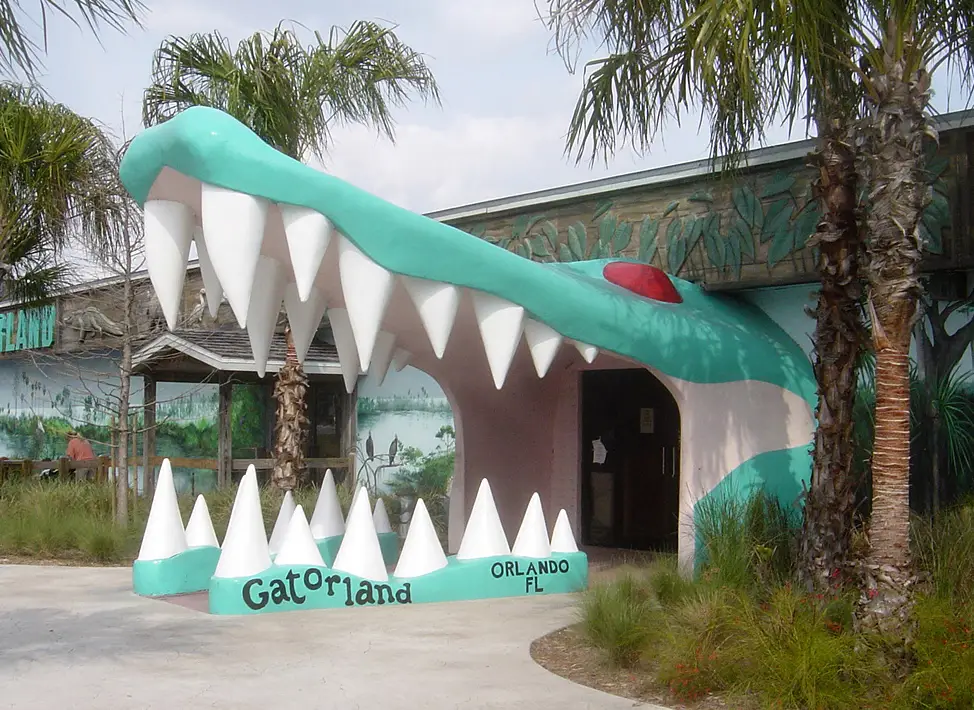
Before Disney World dominated central Florida tourism, Gatorland drew crowds with its signature show featuring alligators leaping vertically from the water to snatch raw chicken from trainers’ hands. The primitive wooden bleachers positioned directly over murky waters teeming with dozens of alligators created a visceral sense of danger that would never pass modern safety standards. Watching these prehistoric creatures explode from the water with shocking speed made many visitors instinctively recoil, even though they were supposedly safe in the viewing stands.
The attraction’s entrance – walking through the open jaws of a massive concrete alligator head – set the tone for an experience that played on primal fears. The facility’s “breeding marsh” featured hundreds of alligators in unnaturally close proximity, creating a writhing mass of reptiles that seemed straight out of a nature documentary’s most disturbing footage. For ’70s children accustomed to seeing sanitized animals in traditional zoos, the raw proximity to creatures that clearly viewed humans as potential food sources created lasting impressions that bordered on traumatic for more sensitive young visitors.
6. Prehistoric Forest (Irish Hills, Michigan)
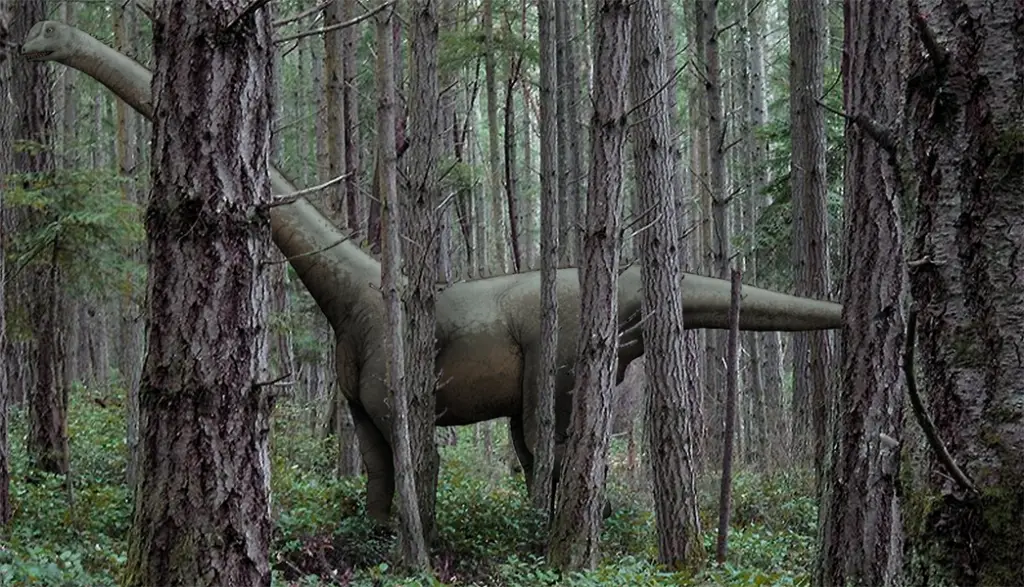
This abandoned dinosaur park featured dozens of life-sized dinosaur sculptures lurking among actual trees, creating a deeply unsettling juxtaposition of the natural and the artificial. The dinosaurs’ faded paint, cracking fiberglass, and fixed expressions gave them an undead quality that was especially pronounced on overcast days when few other visitors were present. Children walking the paths would often glimpse dinosaur figures through the trees before fully encountering them, creating genuine jump-scares that the attraction’s creators likely never intended.
The park’s isolated location in the already remote Irish Hills area meant visitors often found themselves alone with these silent prehistoric sentinels. A particular Tyrannosaurus Rex positioned near a bend in the trail was notorious for terrifying unsuspecting children who would turn the corner and find themselves face-to-face with its gaping jaws. The attraction closed in the 1990s, but in recent years, urban explorers have documented the now-completely abandoned park, where weathered dinosaurs continue their silent watch – a ghost of ’70s roadside culture that has literally become the horror movie setting it always spiritually resembled.
7. The London Bridge Experience (Lake Havasu City, Arizona)
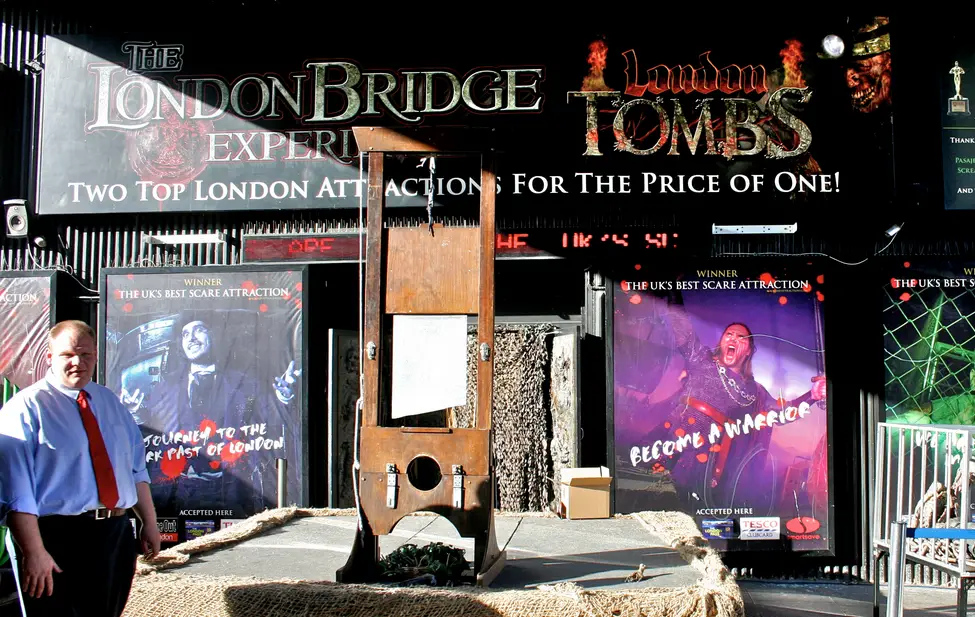
When businessman Robert McCulloch purchased London’s actual bridge, had it dismantled, and reconstructed it brick by brick in the Arizona desert during the early ’70s, he created one of the most surreal tourist experiences in America. The incongruity of a genuine medieval European structure standing amid the harsh desert landscape created an unsettling sense of displacement, as if reality itself had somehow fractured. Tour guides recounted the bridge’s grim history, including tales of decapitated heads displayed on spikes and prisoners kept in cells beneath the structure, stories that fascinated and disturbed young visitors.
The English village constructed around the bridge to create context instead achieved the opposite effect – an uncanny valley of architecture that felt like a movie set abandoned by its production company. During the scorching Arizona summers, few tourists braved the heat to visit the attraction, meaning families often found themselves virtually alone on the bridge, their footsteps echoing off stonework that had witnessed centuries of history before being inexplicably transported to this desolate setting. The bridge’s nighttime lighting created dramatic shadows that transformed the attraction from merely odd to genuinely eerie, leading many children to ask their parents the question that had no satisfying answer: “But why is it here?”
8. Foam Henge (Natural Bridge, Virginia)
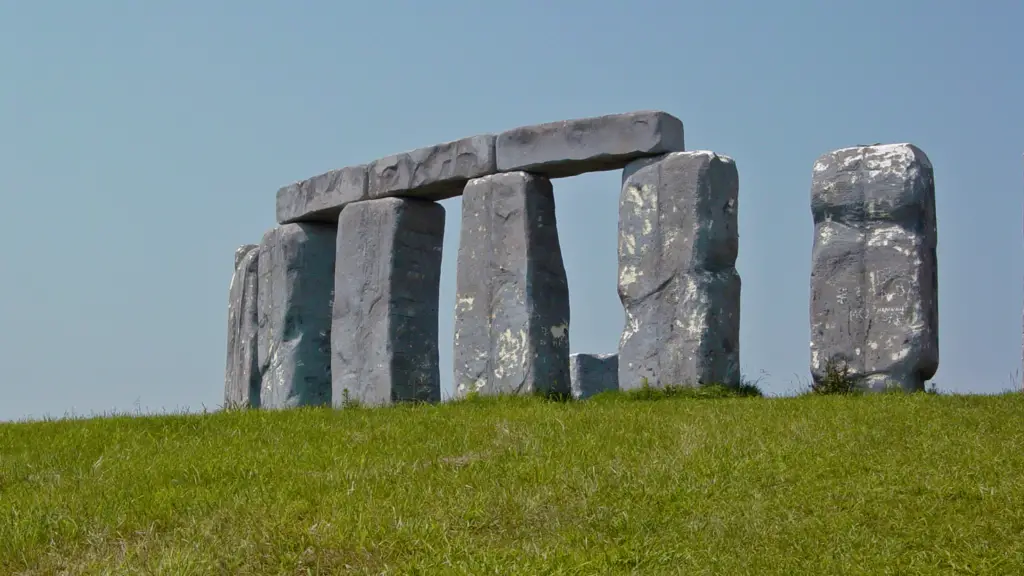
This full-scale replica of Stonehenge constructed entirely from styrofoam blocks achieved the rare distinction of being both comically absurd and genuinely unsettling in its perfect replication of the ancient monument. Created by artist Mark Cline, the attraction featured massive foam monoliths arranged in the same astronomical alignment as the original, creating an illusion that was broken only when visitors touched the surprisingly lightweight structures. The knowledge that these massive “stones” could be easily moved despite their appearance added a layer of cognitive dissonance to the experience that many visitors found deeply uncomfortable.
The attraction’s location on a windswept hill created an environment where the foam stones sometimes emitted creaking sounds as they settled or responded to temperature changes. Visiting during cloudy weather or near sunset maximized the unsettling quality, as shadows played across the white surfaces in ways that sometimes created the illusion of movement. For children raised on tales of Stonehenge’s mysterious origins and possible supernatural powers, encountering this uncanny replica in the Virginian countryside often led to uncomfortable questions about whether the copy might somehow share the original’s rumored mystical properties.
9. Winchester Mystery House (San Jose, California)

Though constructed decades earlier, this architectural oddity reached peak tourism popularity in the paranoia-friendly 1970s when interest in the supernatural soared. The 160-room mansion built by Sarah Winchester, heiress to the Winchester rifle fortune, supposedly based on instructions she received from spirits during séances, featured staircases leading to nowhere, doors opening onto blank walls, and windows overlooking interior rooms. The guided tours emphasized the house’s connection to guilt over the deaths caused by Winchester rifles, suggesting Sarah built continuously for 38 years to appease the spirits of those killed by her family’s invention.
The house’s disorienting layout, with its sudden dead ends and unexpected level changes, created genuine confusion among visitors who sometimes became separated from tour groups despite guides’ best efforts. Children were particularly susceptible to becoming disoriented in the house’s maze-like corridors, making the attraction a common setting for family arguments and occasional tears. The 1970s tours leaned heavily into supernatural explanations, with guides pointing out “cold spots” and sharing accounts of paranormal experiences, priming visitors to interpret the house’s genuine architectural oddities through a lens of supernatural dread rather than as the product of an elderly woman’s eccentric building projects.
10. Rock City’s Fairyland Caverns (Lookout Mountain, Georgia)

This underground attraction featuring black-light illuminated scenes from fairy tales created a psychedelic nightmare landscape that disturbed as many children as it delighted. Located within the popular Rock City attraction near Chattanooga, Tennessee, the caverns presented familiar fairy tale characters as three-dimensional fluorescent figures frozen in eternal tableaux, their glowing features accentuated by the darkness. The combination of confined cave spaces, disorienting black lights, and fairy tale scenes that emphasized the grimmer aspects of these stories created an atmosphere that many children found overwhelming.
Parents who expected whimsical fairy tale representations were often surprised by scenes depicting genuinely frightening moments like the witch attempting to shove Hansel into the oven or the wolf pursuing Red Riding Hood. The attraction’s final room featured a rotating black-light mural called “Mother Goose Village” where figures moved mechanically in endless repetitive motions that became increasingly unsettling the longer one watched. For many ’70s children, the caverns represented their first confrontation with the uncanny valley effect, where figures appeared almost but not quite alive, existing in a disturbing liminal space between animation and stillness.
11. Holy Land USA (Waterbury, Connecticut)
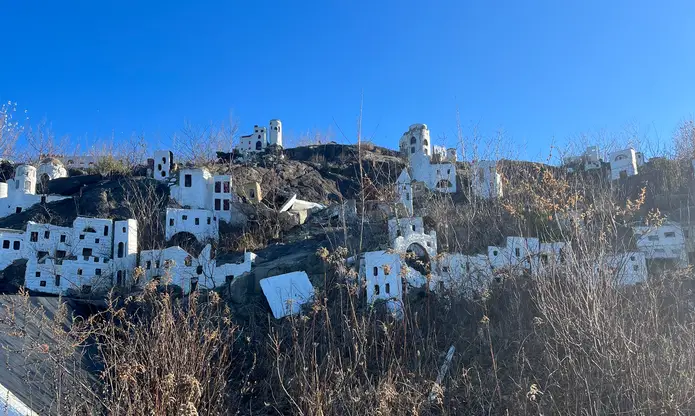
This amateur biblical theme park created by attorney John Baptist Greco featured crude miniature replicas of Jerusalem and Bethlehem constructed from recycled materials like bathtubs, sheet metal, and concrete. The handmade quality of the exhibits, combined with their gradual decay throughout the ’70s as maintenance declined, created an eerie landscape that felt abandoned even when other visitors were present. Miniature buildings representing biblical Jerusalem stood alongside life-sized representations of the Garden of Gethsemane and Calvary, creating a disorienting shift in scale that contributed to the site’s dreamlike atmosphere.
The centerpiece of the attraction – a 56-foot steel cross visible for miles – loomed over the 18-acre site, drawing attention to what otherwise might have been mistaken for an elaborate junkyard. As the attraction declined in popularity and maintenance throughout the decade, the pathways became overgrown and structures began collapsing, creating genuine physical hazards that matched the spiritual warnings posted throughout the park. After dark, the illuminated cross created dramatic shadows across the decaying biblical scenes, transforming the well-intentioned religious display into something that felt more appropriate for a horror film setting.
12. Prairie Dog Town (Oakley, Kansas)

This roadside zoo featuring a five-legged cow, a six-legged steer, and a two-headed calf alongside a prairie dog colony marketed itself with signs promising “The World’s Largest Prairie Dog!” – which turned out to be merely a concrete statue. Visitors paid admission to enter a dusty compound where glass cases displayed taxidermied animal oddities in various states of decay, their fur worn thin from decades of display. The live prairie dogs themselves appeared remarkably ordinary after the buildup, creating a sense of anticlimax that somehow made the experience even more disquieting.
The attraction’s real horror lay in the conditions of the live animal exhibits, which failed to meet even the minimal standards of the era. The gift shop sold dried prairie dog paws as keepsakes, a practice that would be unthinkable today but perfectly captured the unsettling blend of exploitation and entertainment that defined many ’70s roadside animal attractions. Children excited to see unusual animals often left confused and disturbed by the experience, particularly after viewing the malformed taxidermied specimens whose genetic abnormalities were presented as entertainment rather than with any educational context.
13. Lucy the Elephant (Margate, New Jersey)
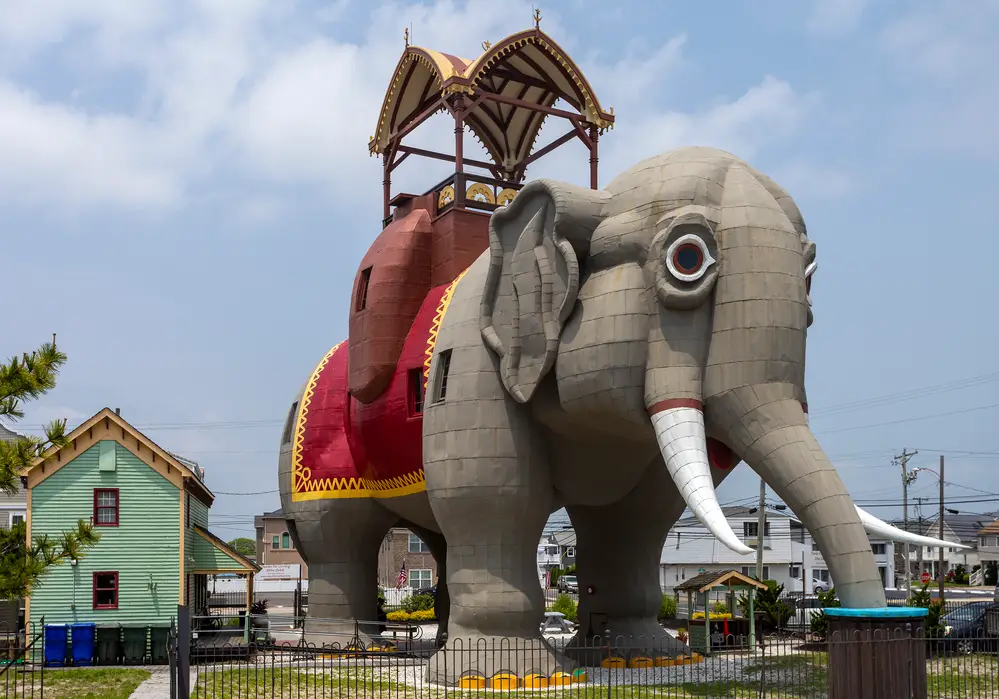
This six-story elephant-shaped building constructed in 1881 experienced a revival in the 1970s after narrowly escaping demolition, drawing tourists to climb the spiral staircase in its leg and view the Atlantic Ocean from windows in its howdah. While ostensibly whimsical, the structure’s massive scale and hollow interior created an experience more unsettling than delightful, particularly on windy days when the building’s wooden structure would creak and groan. Children climbing the narrow, winding stairs inside the elephant’s leg often experienced genuine claustrophobia, emerging into the main chamber breathless and disoriented.
The building’s history included stints as a tavern, cottage, and reportedly even a brothel, lending the structure an adult past that seemed at odds with its cartoonish exterior. The elephant’s fixed grin and unblinking eyes, visible for miles along the shoreline, created the impression of a massive sentinel watching approaching visitors with an unchanging expression of forced cheer. On foggy days, when the structure loomed suddenly out of the mist, travelers reported genuine moments of shock at encountering the massive pachyderm in such an incongruous setting – a reaction that the attraction’s 1970s marketing materials proudly highlighted rather than downplayed.
The ’70s represented the last gasp of truly bizarre, unregulated roadside attractions before interstate highways redirected traffic and changing entertainment expectations raised the bar for tourist stops. These quirky landmarks offered more than mere photo opportunities – they provided genuine encounters with the strange, the unsettling, and occasionally the sublime. While modern roadside attractions tend toward sanitized experiences with gift shops larger than the exhibits themselves, these ’70s oddities offered something increasingly rare: moments of genuine surprise along America’s highways. Perhaps their lingering discomfort was precisely their value – proving that the most memorable journeys include moments that challenge our sense of reality rather than merely confirming it.


